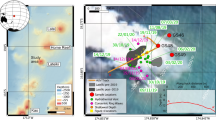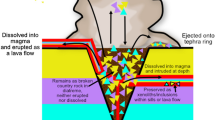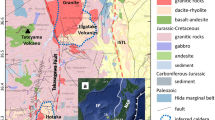Abstract
MR. C. M. BRISTOW'S pertinent comments on my communication dealing with froth-flows in Kenya underline a fundamental difference in interpretation of these rocks between me and geologists of the Ministry of Works, Kenya. The latter have attempted to fit the evidence from this field into a framework based on the orthodox concepts of ignimbrite genesis—following Fenner1, Marshall2, Mansfield and Ross3, and Gilbert4. I have come to the conclusion that certain features of the flows in question are incompatible with these concepts: and that some departure from the concept of ignimbrites (as clearly defined by Marshall2–products of deposition from immense clouds or showers of intensely heated but generally minute fragments of volcanic magma) is necessary, in this case. Grange5, working in the same field as Marshall, remained unconvinced that the process suggested by Marshall had been responsible for the unusual rock types, and preferred to invoke an origin in effusive processes, and Steiner6 has lately invoked such processes to explain anomalous features in certain rocks of this field. Even the foremost, active exponents of welding and compaction (litho-static load) processes, Ross and Smith7,8, have come a long way from Marshall's original concept. The description of an eruption of Cotopaxi quoted by them7 as possibly a typical ‘ash flow’ eruption suggests effusion rather than the process envisaged by Marshall. This eruption could equally well have represented vesiculation, expansion and partial or complete rupturing in a rising magma column and effusive flow, quite independent of welding processes—a froth-flow eruption as envisaged by Kennedy9 and Boyd10.
This is a preview of subscription content, access via your institution
Access options
Subscribe to this journal
Receive 51 print issues and online access
$199.00 per year
only $3.90 per issue
Buy this article
- Purchase on Springer Link
- Instant access to full article PDF
Prices may be subject to local taxes which are calculated during checkout
Similar content being viewed by others
References
Fenner, C. N., National Geog. Soc., Tech. Papers (Katmai Ser.), 1 (1923).
Marshall, P., Trans. and Proc. Roy. Soc. N.Z., 64, 323 (1935).
Mansfield, G. R., and Ross, C. S., Trans. Amer. Geophys. Union. Sixteenth Ann. Meeting, 1, 308 (1935).
Gilbert, C. M., Geol. Soc. Amer. Bull., 49, 1829 (1938).
Grange, L. I., N.Z. Sci. and Tech., 16, 57 (1934).
Steiner, A., N.Z. Geol. Surv. Bull., 68 (1960).
Ross, C. S., and Smith, R. L., U.S. Geol. Soc., Prof. Paper, 366 (1961).
Smith, R. L., Geol. Soc. Amer. Bull., 71, 795 (1960).
Kennedy, G. C., Geol. Soc. Amer. Special Paper, 62, 489 (1954).
Boyd, F. R., Geol. Soc. Amer. Bull., 72, 387 (1961).
Hausen, D. M., Mississippi Acad. Sci. J., 5, 209 (1954).
McTaggart, K. C., Amer. J. Sci., 258, 269 (1960).
Author information
Authors and Affiliations
Rights and permissions
About this article
Cite this article
MCCALL, G. Kenya Ignimbrites. Nature 196, 365–367 (1962). https://doi.org/10.1038/196365a0
Issue Date:
DOI: https://doi.org/10.1038/196365a0
This article is cited by
-
Monte Amiata volcano (Tuscany, Italy) in the history of volcanology: 2—its role in the definition of “ignimbrite” concepts and in the development of the “rheoignimbrite” model of Alfred Rittmann
Rendiconti Lincei. Scienze Fisiche e Naturali (2020)
-
Recommendations for further studies on the peralkaline oversaturated volcanic rocks
Bulletin Volcanologique (1974)
-
Froth flows and globule flows in Kenya
Die Naturwissenschaften (1972)
-
Volcanoclastic Rocks in Tenerife, Canary Islands
Nature (1967)
-
On the genesis of ignimbrites how ignimbrites and other pyroclastic products originate from a flowing melt
Bulletin Volcanologique (1967)
Comments
By submitting a comment you agree to abide by our Terms and Community Guidelines. If you find something abusive or that does not comply with our terms or guidelines please flag it as inappropriate.



